Imran Khan looks a bit like he used to at the top of his run-up, keen as a rapier and bustling with intent. He’s a man on a mission, addressing public meetings twice a day across electoral battlegrounds. Still extremely charismatic at 65, he’s the only real crowd-puller whose presence can make a difference to a candidate running under the banner of the Pakistan Tehreek-e-Insaaf (PTI). Pakistan, like India, labours under the slippery first-past-the-post system—a few floating votes can settle a game. And if anyone can swing the ball in dead air, it’s the Pathan.
The Pathan Suits: Can Imran Khan Lay A New Path For Pakistan’s Fractured Polity?
Rawalpindi is seen to patronise him. And it’s a conducive pitch electorally—even if Nawaz Sharif, playing the victim card, poses a threat from prison. But the pennants of Imran Khan’s PTI fly the highest. Can he lay a new path for Pakistan’s fractured polity?
The schedule must be gruelling even for a physically fit Imran, but it doesn’t show. The excitement of what comes next must be driving him. Pakistan is staring at an electoral landscape shorn of Benazir Bhutto and Nawaz Sharif, the duo that dominated politics in the post-Zia era. That’s a huge, roiling vacuum. What that means is, perhaps for the first time since 1996, when Imran founded his party, there is unparalleled confidence about the PTI’s chances in an election.
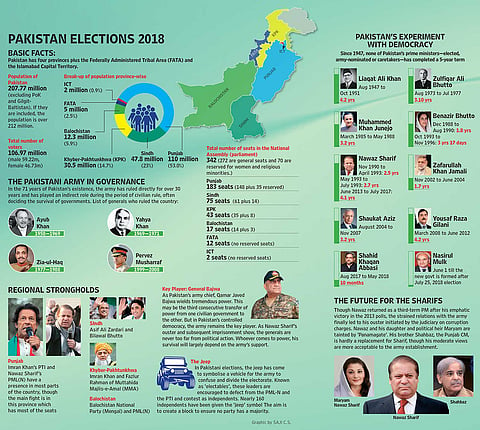
The party may have launched its manifesto after the other two main parties—the Pakistan People’s Party (PPP) and the Pakistan Muslim League-Nawaz (PML-N)—but Imran has been spelling out his agenda for months now. At a big rally in Lahore back in April, he gave his 11-point agenda for governance. A month later, he unveiled his 100-day action plan.
The PTI’s senior leadership is confident enough to assert that it will lead the lower house of parliament and it’s unfazed by the allegation levelled by all other parties that it is the ‘ladla’ (favourite son) of the powers that be. While the PPP and the PML(N) struggle with corruption cases and arrests (as well as security concerns for the latter), the PTI is seen to be racing ahead without any such impediments.
Imran’s journey took 22 long years. But it finally seems that he might just get a seat at the power table. Till 2013, his party had not won more than one seat in Pakistan’s directly elected lower house. The PPP and PML(N) had Pakistan’s regional hinterlands all sewn up, with deep bases in Sindh and Punjab. In a way, it’s the urban middle class that grew rapidly during Gen Pervez Musharraf’s regime that flocked to Imran after the military dictatorship ended, finally allowing the PTI to appear as a mainstream party.
It was no surprise therefore that, even though the PTI did not do too well in Punjab in the 2013 election, his party ran the PML(N) close in urban centres like Lahore and Rawalpindi. It emerged as the second most popular party in Karachi as well. Over the next five years, despite criticism that Imran wasn’t focusing on Khyber Pakhtunkhwa (KPK), the province his party ruled, the former cricketer challenged the Sharif-led PML(N) so aggressively that he has managed to emerge as the main contender in the latter’s home province of Punjab.
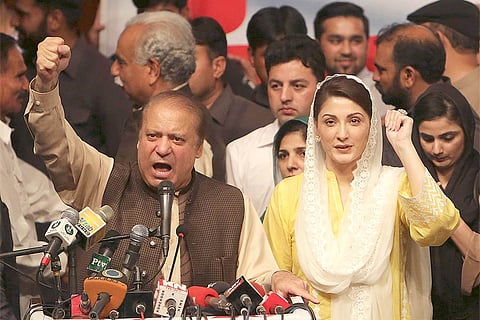
Nawaz Sharif with daughter Maryam at a ceremony for the 20th anniversary of Pakistan’s nuclear tests in Lahore
With the PML(N) beset with grave legal and political problems, it’s no surprise that the PTI thinks it will finally make it. Asad Umer, a senior party leader, feels the PTI will get a solid chunk of seats in the National Assembly. As it is, the PTI, according to most surveys and observers, is set to return as the single largest party from KPK, which has never voted for one party twice in a row.
A victory in Punjab is not a given, like in KPK, but Imran seems to be sitting pretty. In south Punjab—the less developed part of the province where parties tend to be relatively weak and an election victory hinges on influential individuals known as ‘electables’ (often part of the landed elite)—the PTI is in a strong position. In the past couple of months, many electables have defected from the PML(N) to hop on to the PTI bandwagon—as good a signal from the weathervane as you would want.
While Imran promises to strengthen institutions, eradicate corruption and focus on human development, in the words of Asad Umer, it’s hard to say what Imran as prime minister may bring for Pakistan’s neighbours.
Oddly, for a Pakistani so well-known internationally, for cricket and socialising, his foreign policy agenda remains less clearly articulated than his domestic governance plan. Partly, this is because foreign policy is rarely an issue in Pakistani electoral politics. Most parties barely skim the surface of foreign policy in their manifestoes; rarely are the details filled in during speeches or interviews. No wonder, an article in The Friday Times noted: “None of the three parties have come up with ambitious or innovative promises to reboot the foreign policy.”
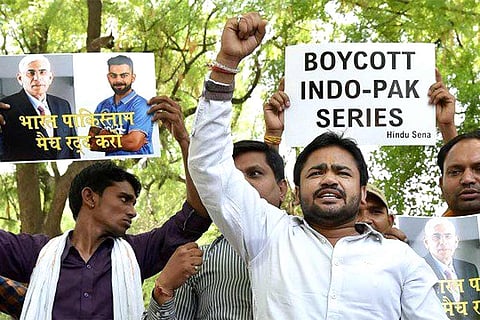
“Nawaz Sharif tried his best to mend ties with India. But India’s aggressive and anti-Pakistan policy has led to the present stalemate.”
The PTI’s manifesto does speak of a dialogue with India and working on a blueprint for the resolution of Kashmir. But few details are available. Critics allege the PTI’s proximity to the military means the latter will continue to dominate foreign and security policy. Or at the very least, when in power, Imran will stick to the prevailing view that while Islamabad will not say no to a dialogue with India, it sees little chance of a breakthrough as long as Narendra Modi is in power.
“The PTI will face more constraints than any other party because of the hawkish line they have taken all along vis-a-vis India. Hence, if there is a visible chance for it to start a structured dialogue process again, it will be hard to sell, especially because of the ongoing case of Kulbhushan Jadhav. But it’s the only party to promise realistic structural changes in the ministry of foreign affairs,” says Mariana Babar, a senior journalist.
All that is still hypothetical, of course. Because, though the PML(N) may be down for the moment, it’s not out of the race. On July 13, Mian Nawaz Sharif and his daughter Maryam Nawaz Sharif put all rumours of a deal—or of the two running away from Pakistan, as they has done in 2000—to rest as they flew back from London to offer themselves for arrest. A week earlier, they had been convicted to ten and seven years’ imprisonment by an accountability court in Pakistan.
They returned amid a harsh crackdown on the PML(N), which had planned a big show of street power in Punjab’s biggest city to welcome them. All day long, party workers and leaders dodged containers, arrests and other hurdles to reach Lahore. Though the main rally did not make it to the airport in time for the flight, journalists allege their channels were discouraged from airing visuals of the crowds in and around Lahore. Scores were arrested from the rally by the police, including top PML(N) leaders, some of them party candidates. The police have also opened criminal cases against thousands of PML(N) members for breaking ‘election rules’. The next day, Shahbaz Sharif, Nawaz’s younger brother, warned that “only the PML(N) is being targeted… and [being denied] a level playing field”, reported Dawn. Though he now leads the party and is its prime ministerial candidate, Shahbaz is not a charismatic crowd-puller.

“Nawaz Sharif went to India and engaged with it to safeguard his business interests . He did not care for Pakistan’s interest.”
The perception is that Nawaz’s absence from the campaign trail will be a huge loss in Punjab, traditionally the province that determines who occupies the executive’s seat in Islamabad. But his dramatic arrest has also set off talks about a sympathy vote. And Sharif is playing the ‘victim’ card to some effect. Even if he hasn’t changed the game conclusively, it’s certainly a new factor for Imran to counter. Others have noted this. For instance, Babar Sattar, a lawyer and commentator, tweeted: “Election 2018 is about #NawazSharif.”
Of the 272 national assembly seats in the lower house, 148 are from Punjab. The other three provinces share the remaining 129. Hence, it’s said that the road to Islamabad passes through Punjab. This is especially axiomatic for the PML(N), essentially a Punjab-based party. It swept the province last time to dominate the lower house, with little more than a symbolic presence in the other provinces.
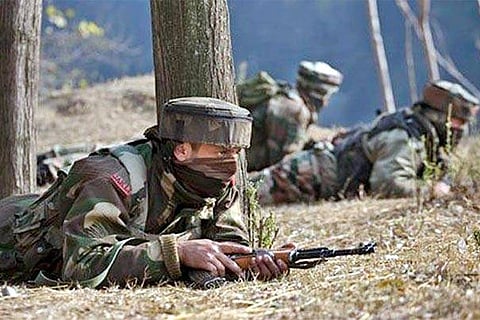
“Modi, you should hear it loud and clear. All Pakistanis are not like Nawaz Sharif. They stand united with their armed forces.”
This time around, though, his party may pay a price for his attack on the military establishment. That onslaught, after his disqualification, has caused not a little private dismay among his party leadership. Besides his own cases, the National Accountability Bureau has, in recent months, aggressively pursued corruption cases in Punjab which has been ruled by Shahbaz for a decade. Senior party leaders have been called in multiple times for questioning. A bureaucrat close to Shahbaz has been under arrest since February.
The PML(N) fell afoul of the establishment in 1993 and 1999 and lost power on both occasions; it’s not a new experience for them. In the last week of June, the judiciary also disqualified two PML(N) candidates for contempt of court despite widespread criticism. In reaction to one disqualification, that of a former federal minister, Daniyal Aziz, a confidant of Maryam Nawaz, the latter said in London, “Why don’t they disqualify the entire party in one go instead of doing it one by one?” It’s hard to remember the last time an election’s fairness was called into question so vociferously.
The defections in south Punjab create another factor of fluidity. Six former assembly members rejected the PML(N) tickets they had been awarded at the last moment, leaving the party no time to nominate new candidates. “The PML(N) has left so many seats uncontested all over Pakistan…as if it’s not a serious contender,” says Asha’ar Rehman, resident editor of Dawn in Lahore.
The party also faces a threat from new religious parties such as the Tehreek Labaik, which is reaching out to the Barelvi vote, traditionally seen to be part of the PML(N) support base. Such parties may not be able to win seats but can change the outcome in closely contested races.
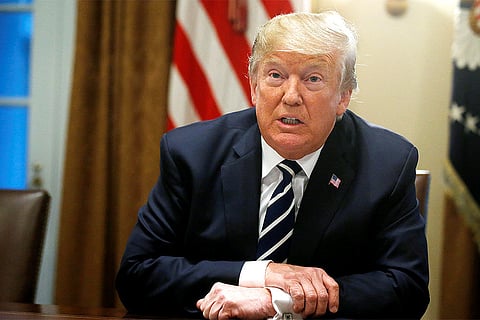
“Yes, I will meet but I dread it. Whether we will be able to communicate, I am not sure. But of course, we will have to work with the United States.”
In this context, if Nawaz is unable to campaign in the final weeks before the election, a victory might be tough to achieve. To provide a parallel, the PPP’s Bilawal Bhutto and his father were unable to hold any rallies in Punjab in 2013, and the party was virtually wiped out in the province.
However, not everyone agrees with this assessment. For many, Sharif’s defiance and his popular standing in Punjab can offset his physical absence from the campaign trail. On July 18, The News quoted journalist Nusrat Javeed as saying, “the PML(N) votebank will gel with Sharif’s return, the campaign will be intense.” Others say it may be hard for the PML(N) to counter this forced enfeeblement, but the beneficiary will not be PTI, but the independent electables. They foresee a hung parliament and a weak government.
Electables are a constant in every general election; in 2008, independent candidates in Punjab garnered around 11 per cent of the vote (PPP and PML-N got short of 30 per cent each). This time, they have taken on a sinister connotation due to two factors. One, the sudden implosion of PML(N) in Balochistan, which cost it its majority in the Senate, with a relatively unknown Baloch politician now Senate chairman.
The second factor is more intriguing: the Election Commission’s decision to give the ‘jeep’ symbol to two PML(N) stalwarts who left the party on the eve of polls—Nisar Ali Khan, who served as Nawaz’s interior minister, and Zaeem Qadri, who had served as the Punjab government’s spokesman. Dawn reported that in Punjab’s 120 constituencies alone, as many as 66 independents will be contesting polls on the jeep symbol. It’s hard to imagine them forming an actual party after the election, but they can play a role in a hung parliament.

PPP Chief Bilawal Bhutto Zardari campaigns in Peshawar. The party is a pale shadow of its former self.
The PPP, meanwhile, is a shadow of its former self; despite Benazir’s son leading it, it is predicted to be limited to Sindh, home province of the Bhuttos. Having been decimated in Punjab in 2013, the last five years have gone waste: minus a charismatic leader, the party has been unable to revive itself there.
BB’s widower, former president Asif Ali Zardari, is seen to be a liability as far as the voter in Punjab is concerned. He has shown little comfort with populist politics, but is at home with what is called ‘jod tod ki siyasat’. So instead of attempting to improve the PPP’s electoral chances, he aims to play kingmaker in case of a hung parliament. That seems to be the ceiling of ambition for the party that once was the only party of the federation in Pakistan post-1971.
So will a party born a quarter century after the 1971 war sweep the game away? Will the PML(N) trump the odds? Or will democracy have to rest on the loose sands of a coalition regime? Anything, it seems, is possible in this election. Rarely has an election been so feverishly contested, in more ways than one, and been so uncertain.
By Arifa Noor in Islamabad